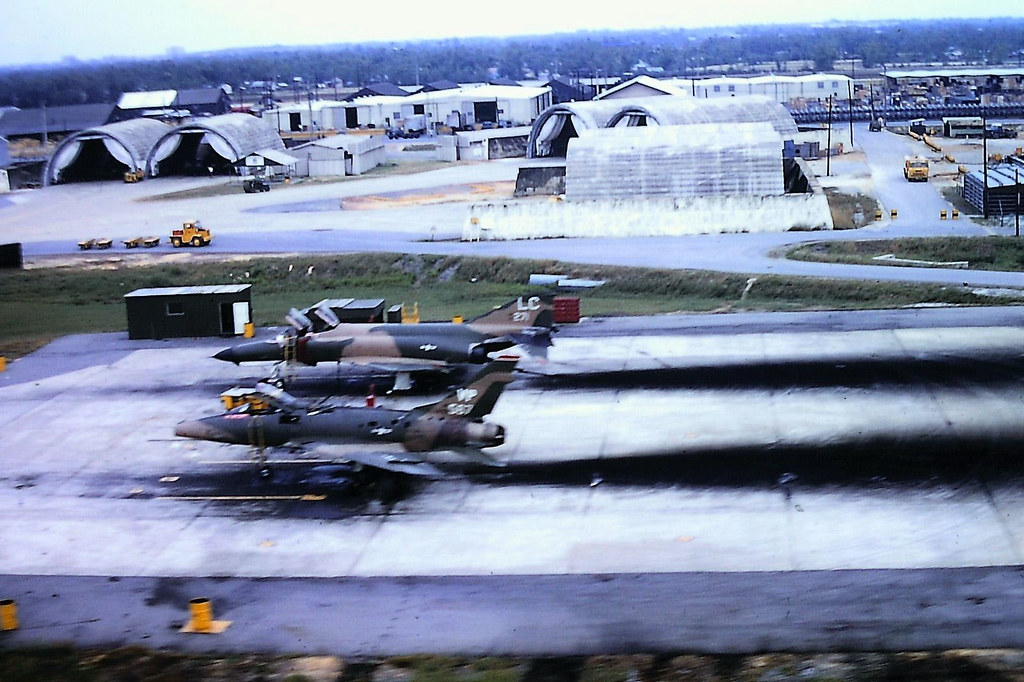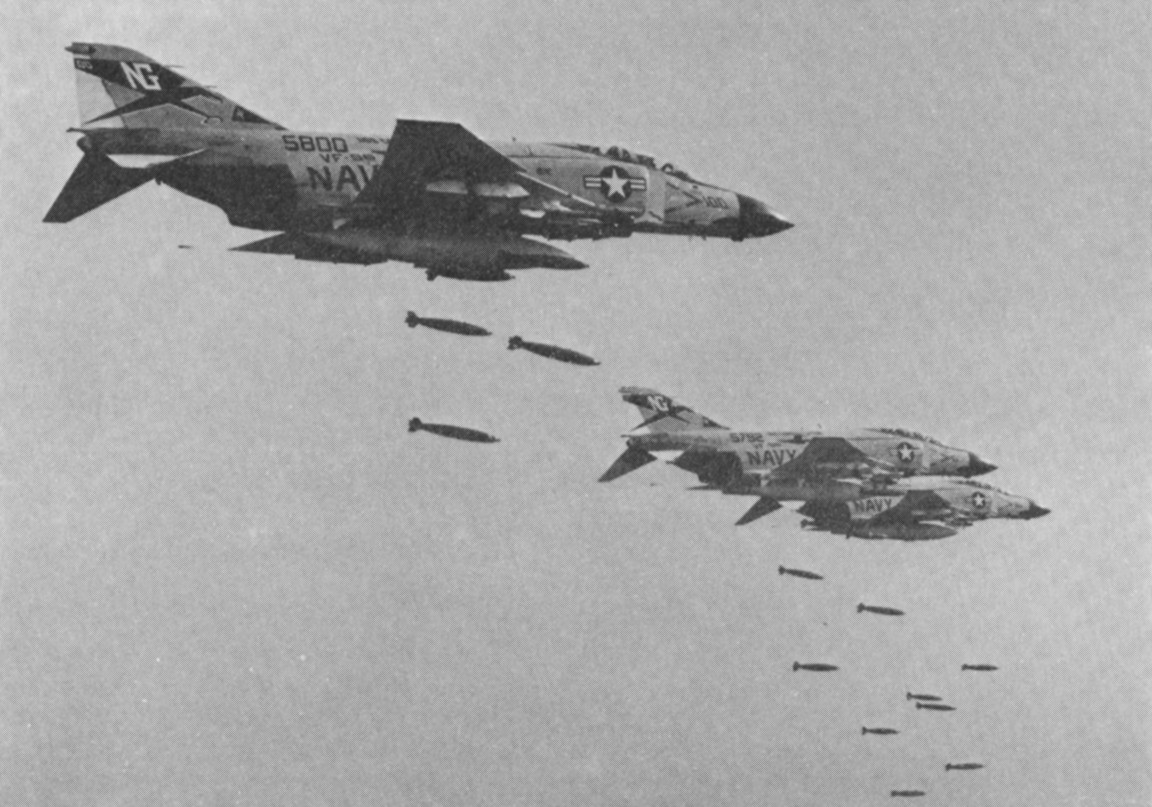I understand that times and technology changes and advances, but whenever I think of the F-4 I go back to it's role in Vietnam and to the aviators that flew her.
For decades the Phantom performed every combat task thrown at it.........................almost every mission ever defined.
Da Nang
Lt. Guy Freeborn:
Combat air patrol missions were proactive: Instead of escorting or defending, F-4s went looking for trouble. MiG pilots with North Vietnam’s air force were happy to oblige. Part of a two-Phantom patrol to waylay Hanoi-based MiGs, Guy Freeborn launched from the USS
Constellation on August 10, 1967. “We were hungry,” says Freeborn, who had never encountered a MiG. Lurking beneath a thin cloud layer, “we figured we might be pretty close to their path. Then, holy crap, here come three MiG-21s out of the clouds right over us.”
The Phantoms shifted into afterburner and sped to 575 mph to develop enough energy to turn aggressively. F-4s hemorrhaged speed while turning—“It was a big, dirty airplane in terms of drag,” says Freeborn—so MiGs could generally out-turn the Phantoms. But the Russian fighter’s fancy footwork didn’t often trump the F-4’s brute, drag-strip acceleration.
The lead Phantom launched two Sparrow missiles, which lost radar lock on the MiGs. Freeborn had other issues beside the finicky, radar-guided Sparrow: Behind him sat a RIO with no combat experience. “I felt I couldn’t rely on him to stay cool, get a radar lock-up, and do what he had to do,” he recounts. As the Phantoms rapidly closed the gap, he chose “Heat” on his front-seat weapons selector and launched an AIM-9 Sidewinder. The streaking heat-seeker locked on to and hit one of the MiGs. Though smoking and trailing fuel, the fighter remained airborne. Before Freeborn could unleash the coup de grâce, the pilot in the lead F-4 finished off the MiG with a Sidewinder. “I told my backseater, ‘Look! That bastard just shot
my MiG!’ ”
With only one target remaining, Freeborn quickly triggered another Sidewinder, which promptly misfired. “I said, ‘Oh man, it’s just not my day.’ ” He cycled the weapon selector once more and lit the next AIM-9. “That one blew him to pieces,” he says. He later discovered that neither MiG pilot had survived.
The third MiG-21? Last seen miles away, “streaking back towards Hanoi,” says Freeborn."
One of the greatest AF aviators of all time, triple Ace of WWII (flying P-38 Lightnings and P-51 Mustangs) and Vietnam, Brigadier General Robin Olds. (a Colonel in this photo - in Vietnam) He completed 152 combat missions, including 105 over North Vietnam. Utilizing air-to-air missiles, he shot down over North Vietnam two Mig-17 and two Mig-21 aircraft, two of these on one mission. The true definition of Badass.
Shortly after Robin retired from the Air Force in 1977, he was invited to give a speech at Davis-Monthan AFB in Arizona to a mixed audience of fighter pilots and Strategic Air Command (SAC) personnel. He began his speech by saying, "My name is Robin Olds and I want to identify myself to everybody in this room: Peace is not my profession!" The SAC members of the audience turned red in the face. In front of them stood one of the most decorated officers from the Vietnam War poking at their beloved motto, "Peace is our profession."
Here is what he looked for in a pilot:
"I'll tell you what -- I'll tell you what I try to look for in any guy: Is he outgoing? Is he aggressive? In other words, does he like sports? Is he a good party guy? That's part of being outgoing. Is he gregarious? Is he individualistic in the sense of knowing his own mind? Does he have a good grin on his face? Okay?"
Capt. Steve Ritchie destroyed five MiG-21s during Operation Linebacker in 1972.
“The 8th of July mission was the most intense, the most exciting mission that I ever flew. Everything worked. During that minute and 29 seconds I drew on all my life experiences. Every part of my training and education came together in that moment and it worked. Few people ever experience that moment where everything jells. It's a feeling that is hard to describe.
“When the mission began, one of the earlier MiG CAP flights had been hit by a MiG. He had broken formation and was headed out, bleeding fuel and hydraulics. He was announcing his position, heading, and altitude on the emergency frequency, a very bad idea, because the North Vietnamese monitored the emergency frequency and when they heard a cripple, leaving by himself, they sent MiGs after him. So we headed toward the fellow that was in trouble, when ‘Red Crown’ and ‘Disco’ [RC-121 radar control aircraft] called additional MiG activity. You can imagine the adrenalin was beginning to pump. I headed to low altitude, and got ‘Heads Up’ call, which meant that the MiGs had us in sight and they had been cleared to fire.
“I really began to look around at that point, because we didn't have them in sight. I rolled out on an easterly heading and stayed there about 8 seconds, when I got a call from ‘Disco’, 150 miles away orbiting over Laos, looking at the whole ring of its radar scope. I heard among the static: "Steve, 2 miles north of you." I made an immediate left turn from my east heading to the north, picked up a MiG-21 at 10 o’clock. Now, if I’d stayed on an easterly heading, the MiG would have been right in my rear quarter, and I probably wouldn’t be here to tell the story today.

“Pick it up at 10 o’clock, rolled left, dropped the external fuel tanks with full afterburner. We passed about 1,000 feet from each other. I could see the pilot in the cockpit. It was a bright, spit-polished superb MiG-21, with bright red stars. When I saw the lead MiG, the strong tendency was to immediately turn, to try to get an advantage. I knew there were two, because they had called ‘Two Blue Bandits.’ But I didn’t see #2. So, I waited, I rolled level, pushed the nose over and waited. Sure enough, #2 came along about 8,000 feet away. Immediately when he passe, I made a 135 degree turn, level, 90, 135, flaps, nose down sliding turn about 6.5 g.”
[This last sentence is confused, as it was a TV interview. He used his hands to explain his actions to the TV team, something very typical for fighter pilots. Ritchie meant to say: “I started a turn of 135 degrees, I leveled waiting for the MiG #2, I rolled 90 degrees, re-started the turn of 135 degrees, I engaged flaps and turned with my nose slightly down, etc.”]
“I couldn’t see what was happening back over there. About half of this turn, I began to roll out of the 135 degrees and as I rolled out of 135 degrees I began to look back, thinking that they’re going to be somewhere back around here [indicated a position at 4 o’clock] to my great surprise I saw a MiG up over here [indicated a position at 9 o’clock], in the opposite direction of where I would expect the MiG would be, because instead of turning to the left and going to this side of the circle [indicated a counter-clockwise turn], they turned to the right and went to this side of the circle [indicated a clockwise turn]. So, now I was in a position with my nose down, and the MiG was high, in a right turn. I was in a left turn, so even if I pulled my nose up, I would have had what is called a very hard angle off.
The target was high in the blue sky, good for a radar lock-on. The MiG saw us, turned down into us. I squeezed the trigger. The first missile went to the center of the fuselage of the MiG and the second missile went thru the fire ball. I felt a nice jump on the stick; a piece of debris shaken up at the leading edge of the left wing.
The lead MiG, the silver MiG, came all the way around the circle and the other three airplanes of our flight were in trail, and then the shiny MiG came on the position of #4, Tommy Feasel. I cut across the circle and achieved a similar position now on the lead MiG that I had on the wingman before, except the lead MiG was a lot better than the wingman. He saw us, forgot about Tommy Feasel, started a hard turn into us. We got a flat turning here, look like just maneuver the airplane.
“I put him in the gunsight, Chuck [Charles DeBelleuve, his RIO in this mission] told me that he had a lock; that’s all I need to know. Missile came off the airplane. It looked like a Sidewinder, it began to snake and did not appear to guide, and I was telling it: ‘the target is over here!’ Suddenly, the missile appeared to do a 90 degree right turn, and it hit the MiG in the fuselage. The missile was pulling about 25 g and was accelerated about twelve hundred miles an hour when it hit, so you can imagine the explosion.”










